
Date: November 7, 2019
Location: Lat: 31.016°, Long: -78.388333°
Dive Depth Range: 801 - 807meters (2,628 - 2,648 feet)
Access Dive Summary and ROV Data
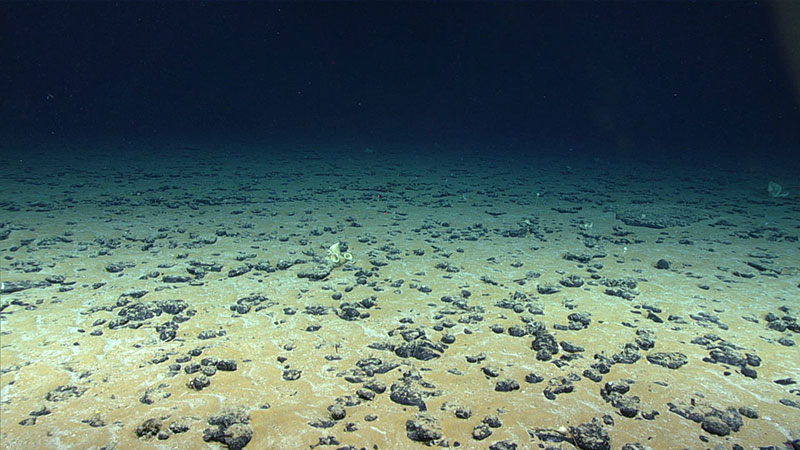
Dive 07 of the 2019 Southeastern U.S. Deep-sea Exploration took us to an underwater landscape much different than that seen on the expedition's previous dives. The nodules seen here and strewn across the seafloor are phosphorites with ferromanganese crusts. They were deposited here millions of years ago and grow about 2 millimeters every million years. Image courtesy of the NOAA Office of Ocean Exploration and Research, 2019 Southeastern U.S. Deep-sea Exploration. Download larger version (jpg, 1.3 MB).
Today’s dive site was identified in collaboration with two of our federal partners in ocean exploration, the U.S. Geological Survey and the Bureau of Ocean Energy Management, and based on mapping data collected during the Windows to the Deep 2019 expedition. The purpose of the dive was to search for signs of disturbance near an area historically subject to the use of experimental deep-sea mining technologies and to gather data about the site’s geology and biology.
Throughout the dive, the flat sandy seafloor was covered in coarse carbonate sand, which consists mostly of the skeletal remains of marine organisms (e.g., pteropods, gastropods, mollusks, and forams), as we have seen in previous dives. However, unlike on previous dives, the seafloor was also strewn with black cobbles. These ferromanganese encrusted nodules ranged in size from ~4-8 centimeters (2-3 inches). In some areas, it appeared that some nodules had been buried by sediment drifts.
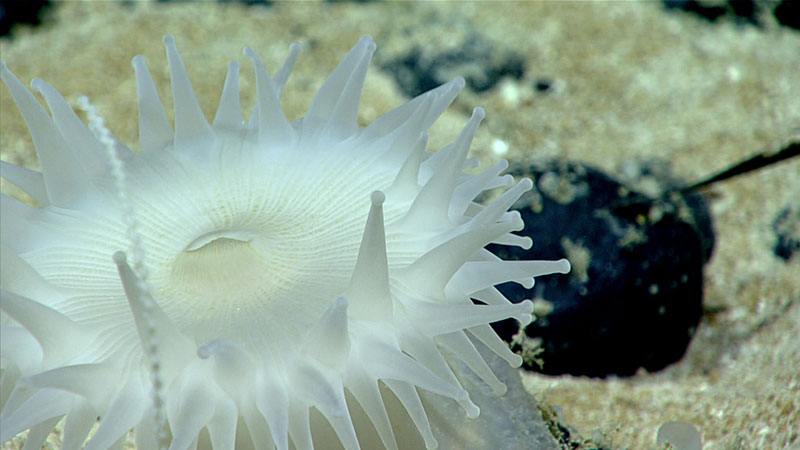
While corallimorphs are usually found on rocks, this one was seen hanging out on a demosponge during Dive 07 of the 2019 Southeastern U.S. Deep-sea Exploration. Occasionally mistaken for anemones, corallimorphs are related to both anemones and stony corals and share characteristics with both. Image courtesy of the NOAA Office of Ocean Exploration and Research, 2019 Southeastern U.S. Deep-sea Exploration. Download larger version (jpg, 821 MB).
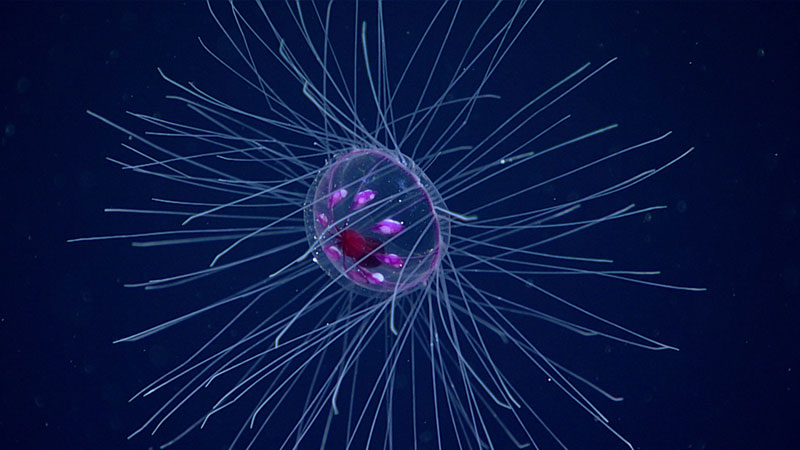
This colorful jelly (Crossota millsae) put on quite a show for the lucky viewers who watched its water column acrobatics while it was feeding during Dive 07 of the 2019 Southeastern U.S. Deep-sea Exploration. Check out video of its display. Image courtesy of the NOAA Office of Ocean Exploration and Research, 2019 Southeastern U.S. Deep-sea Exploration. Download larger version (jpg, 894 KB).
Today we observed at least 15 different sponges (glass sponges and demosponges), brittle stars, crinoids (both sea lilies and feather stars), pancake sea urchins, corallimorphs, jellyfish, bird squids, and a variety of sea stars, corals, and fish, including batfish, sawbellies, tonguefish, cutthroat eels, and a torpedo ray (an electric ray). We also saw some swimming crabs, small shrimp, squat lobsters, isopods, and a decorator crab with a glass sponge on its back.
During today’s dive we collected samples of the sediment and nodules as well as a demosponge (Haplosclerida), which may represent a new species.
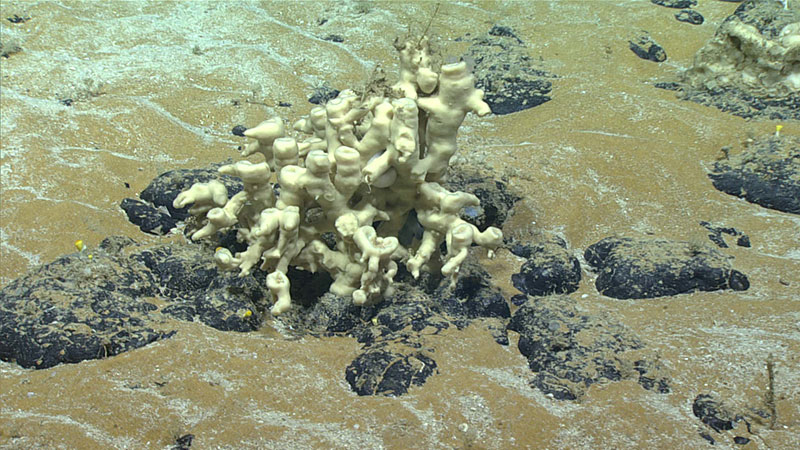
This intricate demosponge (Haplosclerida), reminiscent of a piece of modern art, is representative of the most common type of sponge seen during Dive 07 of the 2019 Southeastern U.S. Deep-sea Exploration. Nevertheless, it was unfamiliar to our scientists, so we took a sample of it to see if it’s a new species. Image courtesy of the NOAA Office of Ocean Exploration and Research, 2019 Southeastern U.S. Deep-sea Exploration. Download larger version (jpg, 1.6 MB).

Location of Dive 07 of the 2019 Southeastern U.S. Deep-sea Exploration expedition on November 7, 2019. Download larger version (jpg, 2.0 MB).
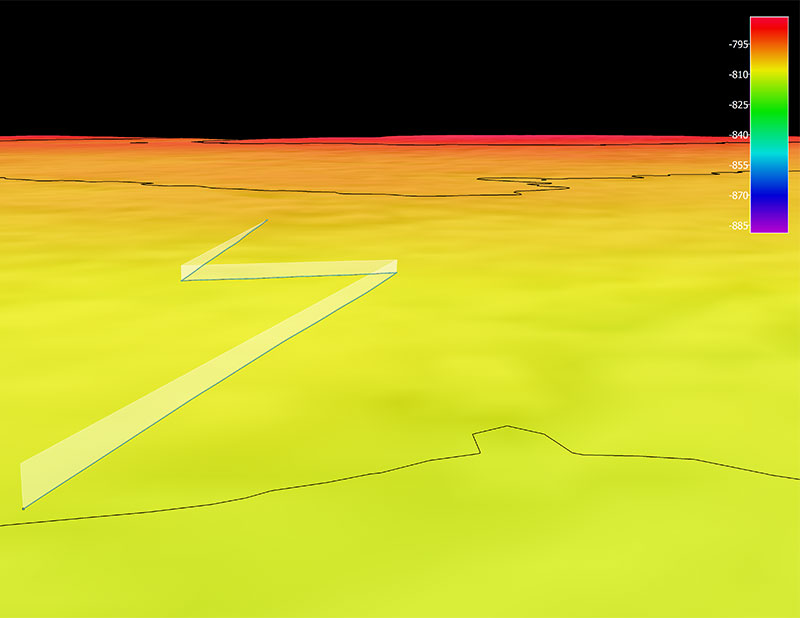
The remotely operated vehicle track for Dive 07 of the 2019 Southeastern U.S. Deep-sea Exploration, shown as a blue line with a white curtain. This mapping data was collected during Windows to the Deep 2019. Legend shows water depth in meters. Download larger version (jpg, 2.2 MB).